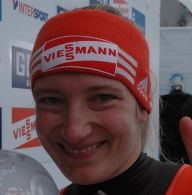Lillehammer (pps) The 1994 Olympic luge track in Lillehammer (Norway) will organize its sixth Viessmann Luge World Cup event. It was four years ago, in the 2009-2010 Olympic season, that the artificially refrigerated track in Hunderfossen, about 15 kilometers away from Lillehammer, played host to its last World Cup event.
It was on December 13, 2009 that the winning series of the German women lugers - undefeated since February 29, 1997 - seemed to hang by a thread. After the first run U.S. luger Erin Hamlin, who claimed the gold medal at the 2009 World Championships in front of a home crowd in early February, was in the lead. But after slipping in the second run she had to defer to her German contenders. Huefner, who then celebrated her 19th individual victory in the Viessmann Luge World Cup, and Geisenberger took the two top spots on the podium. “That was a close call…,” Geisenberger said soberly after the race.
Russia’s Albert Demchenko claimed the victory in the men’s singles, ahead of Armin Zoeggeler of Italy and Germany’s Felix Loch. The Austrian team of brothers, Andreas and Wolfgang Linger, earned the podium’s top spot in the doubles, in front of Christian Oberstolz-Patrick Gruber and Gerhard Plankensteiner-Oswald Haselrieder (both teams from Italy).
Lillehammer will host the 2016 Youth Olympic Games (YOG). The city with the only artificially refrigerated track in Scandinavia is also part of the campaign for Oslo’s bid for the 2022 Olympic Winter Games. Apart from the 1994 Winter Games, Lillehammer also played host to the 1995 World Championships of the International Luge Federation (FIL). At the Games nearly 20 years ago the Olympic Champions were Gerda Weissensteiner (women’s singles/ITA), Georg Hackl (men’s singles/GER) and Kurt Brugger-Wilfried Huber (doubles/ITA). The World Championship titles one year later were claimed by Gabriele Kohlisch (GER), Armin Zoeggeler (ITA) and Stefan Krausse-Jan Behrendt (GER).
The 1,365 meters long artificially refrigerated track has 16 curves and a difference in altitude of 114.3 meters. The maximum downward grade amounts to 15 percent.










